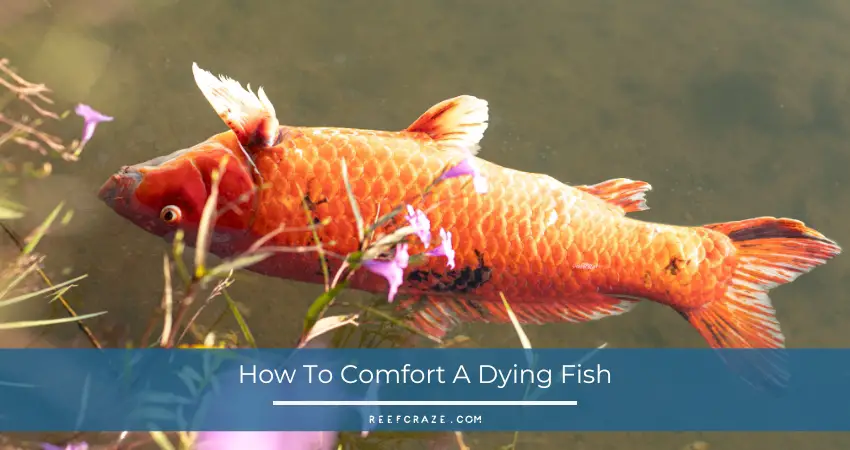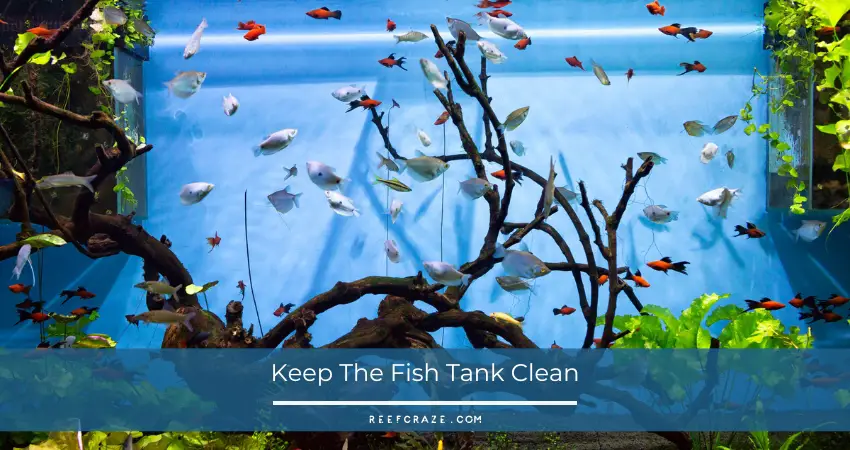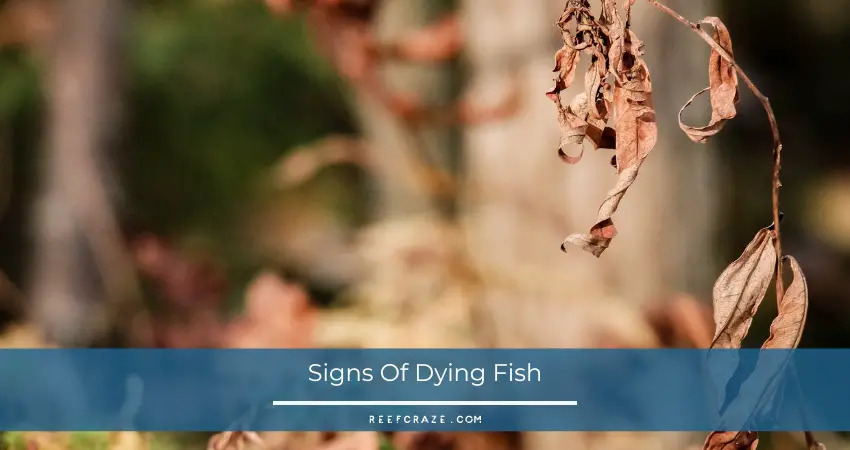As pet owners, we must prepare ourselves to face the death of our favorite pets, no matter how devastating that must feel. Just because death is indispensable and inevitable, we can’t neglect our duty as pet owners and ignore our fish on the verge of their death.
You can comfort your dying fish by keeping the temperature and water quality stable, placing them away from direct sunlight, providing them with a clean tank, and decorating the tank with hiding places for them.
Just because death is inevitable doesn’t mean the pets have to go with little care, abundant stress, and malnutrition. Here’s what you need to know about comforting your dying fish.

What Can You Do To Comfort Your Dying Fish?
A pet fish becomes a part of the family even though their jurisdiction never crosses the tank. So, without a doubt, their final days put a heavy toll on the owner. I am sure no one wants to watch their playful, cheerful fish pacing on to their final days, but even with heavy hearts, we must ensure their last days are cozy and comfy.
1. Keep the Water Temperature Steady
The temperature of the water inside the tank is always an issue of concern for the fish. It is more critical when the fish is on the verge of death. A little fluctuation can switch on the panic mode for that poor soul. So, fixing the temperature as per their requirement and desire is the least you can do for their comfort.
There is no fixed temperature for different types of fishes. Aquarium fishes fall into two categories when it comes to temperature-tropical and cold water. Tropical fishes prefer 75°F-80°F or 23°C-27°C. Since the home temperature usually doesn’t follow this temp setting, tropical fishes require a heated aquarium. Betta is a common tropical fish.
Cold-water fishes prefer unheated aquariums and don’t like to collude with tropical temperature settings. Especially when they are frail and fragile, their body will not be empowered enough to switch suddenly from one temp to another. The most common reference for cold water is Goldfish.
Here are some recommended temperature settings for different kinds of aquarium fish_
| Name Of The Fishes | Approved Temp Setting |
| Minnows | 64-72F |
| Zebra | 64-75F |
| Goldfish | 68-74F |
| Danios | 70-78F |
| Hatchet fish | 72-81F |
| Harlequin Rasbora | 72-82F |
| Cardinal Tetra | 73-81F |
| Guppies | 74-82F |
| Betta | 75-80F |
| Plectostumus | 75-82F |
| Silver Dollar | 75-82F |
| Tiger Barb | 77-82F |
| Clown Loach | 77-86F |
| Rams | 84-86F |
N.B. For the utmost comfort, keep the temperature settings at the upper side of the ranges.
Read Next: Right temperature for a reef tank
2. Keep The pH Level Balanced
It is a wrong concept that all kinds of fish prefer pH-7 water. Depending on the variety and traits of the fish, the required pH level of the water can be slightly acidic or slightly alkaline. Usually, freshwater fish prefer pH levels ranging from 6.8 to 7.5. This range can change for acid-loving fish and saltwater fishes.
Even a 0.3-0.5 pH change can prove fatal for the fish if the duration exceeds 24 hours. It will lead the fish to a stressful environment causing them to panic and become susceptible to diseases. When the fish are dying, even this slight change will increase their stress level exponentially.
Depending on the type of fish you have, a steady pH level, as given in the table, should be maintained.
| Name of the fishes | Approved pH levels |
| Cardinal Tetra | 4.6 – 6.2 |
| Rams | 5.0 – 6.5 |
| Plectostumus | 5.0 -7.0 |
| Clown Loach | 6.0 – 6.5 |
| Harlequin Rasbora | 6.0 – 6.5 |
| Tiger Barb | 6.0 – 6.5 |
| Hatchet fish | 6.0 – 7.0 |
| Silver Dollar | 6.0 – 7.0 |
| Danios | 6.0 – 8.0 |
| Betta | 6.0 – 8.0 |
| Danios | 6.0 – 8.0 |
| Minnows | 6.0 – 8.0 |
| Angelfish | 6.5 – 7.0 |
| Zebra | 6.5 – 7.0 |
| Goldfish | 7.0 – 7.5 |
| Guppies | 7.0 – 8.5 |
Read More: pH in reef tank
3. Keep The Water Quality Sublime
The water is the residence of the fish, and if the resident is dirty and inhabitable, even a healthy, young fish can’t live a prosperous life. To make the water surrounding them a bit comforting, you can provide them with a warm touch before their departure.
To check whether your fish are living in quality water, you must test the water parameters on a regular basis.
For a freshwater aquarium, the water parameter is recommended to be within these ranges.
| Water parameters | Approved Ranges |
| Specific Gravity | 1.023 to 1.025 |
| Ammonia | 0 ppm |
| Nitrite | 0 ppm |
| Nitrate | < 10 ppm |
| Alkalinity | 8 and 13 dKH |
| Calcium | 400 and 450 ppm |
| Magnesium | 1200 and 1320 ppm |
| Phosphate | 0 ppm |
| Iodine | 0.5 to 0.8 ppm |
| Iron | 0.1 to 0.3 ppm |
4. Keep Them Away From Direct Sunlight
Sunlight has both pros and cons in terms of aquarium fish. On the one hand, it keeps the fish vibrant and energized. On the other hand, it exploits algae growth quickly and largely.
But of the dying fish, the paling of the skin is not as crucial as an algae-bloomed tank. Cleaning such a mess is not an everyday task.

Moreover, the heat coming from direct sunlight can alter the temperature of the water that you set for your fish as per the direction. When the temperature drops at night when there is no sunlight, that fluctuation can cause stress for the dying fish. If you must keep the fish under direct sunlight, keep the water temperature a bit lower than usual.
5. Keep The Tank Clean
The Algae, the gloomy color of the water, and the greenery can be pleasant to look at from the outside. But for the habitants of the tank, that ambiance can suffocate them to death. A clean tank will provide maximum comfort for the dying fish. But what causes the tank to get dirty?

The by-product of the wasted food, fish waste, and leftover food is the top culprit for a dirty tank. Also, incessant algae growth can hinder the tank’s cleanliness. Due to such excess by-products and rotten plantations, the amount of nitrate, nitrite, and ammonia will increase exponentially.
That will lead to a reduction of oxygen level inside the tank. For the dying fishes, plenty of oxygen is extremely crucial since breathing and exhilaration is a difficult task for them. Also, without a clean tank, the lights and air can hardly penetrate through the water.
6. Keep The Aggressive Fish Away
A dying fish is physically and mentally sensitive and fragile. A strong presence of an aggressive fish can be stressful for them. Their behavior can increase their anxiety level. Also, due to their belligerent attitude, the dying fish may be left with little to no food. Since they do not have the power or the energy to protest, they can hardly fight back to retrieve their ration.
When your fish is on the verge of death, replace the aggressive fish with another arrangement. But if other fishes are friendly and kind to the dying ones, keep them closer to them.
Read More: Clownfish tank mates
7. Keep Plenty Of Hiding Places
On their final days, fish prefer to be secluded and rested in their hidden chambers, away from chaos and noise. Since they do not enjoy swimming that much around the tank, you must provide them with enough hidden places for them. It can be artificial or natural. Large leaves and caves are among their favorites.
8. Take Vet’s Help
Consulting with a vet is always helpful. Feed your fish according to the vet’s prescription, reset the food menu, and reschedule the feeding time as the vet says.
What Are The Signs Of Dying Fish?
Before death, most fishes manifest some common host of signs. Sometimes, these can indicate any difficulties or symptoms of any disease. But mostly, it brings the news that death is imminent. To provide the fish with last-minute comfort, you must identify the signs.

Loss of Appetite
Fishes are generally eager for their food and swim toward the food when you provide them with their ration. But the old fishes which are in their final days, show apathetic behavior towards food. It is not like they do not have any food provided to them. But they don’t show any excitement or eagerness for such food.
Discoloration Of Their Gills And Fins
The vibrancy of the gills and fish can fade away for numerous reasons. It can be a bacteria attack, fungal injection, excessive ammonia in the water, or due to unbalanced water parameters.
But once you can cross off all these probable reasons from the list, the only probability that remains is death. The discoloration is the sign that your fish is swimming towards death.
Bloated Belly
Another sign of your dying fish is a swollen belly which is termed as ‘dropsy’ because the stomach area looks like it dropped. Due to improper digestion caused by their poor gut, their belly is often bloated and swollen. It can also be a sign of parasite infection or excessive water consumption. If not, it is a clear sign of death.
Inconsistent Swimming Patterns
Fishes who are on their final days do not prefer swimming that much. They prefer to lay lethargically on the bottom of the tank. But when they swim, their movements are slow and abnormal. They swim upside down, sideways, and in a zigzag pattern. Due to poor digestion and low energy, their vigor in swimming reduces rapidly.
How Long Do Aquarium Fishes Live?
It is difficult to calculate fish’s age since tracking their birthday is not always possible. But with some information about the genus and species, we can find the probable longevity of different kinds of fishes. The shortest lifespan of a fish belongs to Killifish, which only lasts for less than 2 years.
Bettas don’t outrun the Killifish by much difference. Their lifespan can be around 2-3 years. Swordtails can live up to 5 years or more. On the other hand, Goldfish can live for 10-25 years.
This may sound crazy because we don’t see them live that long. But with proper care and nutrition, their lifespan can outlast any aquarium pets.
Read More: Clownfish Lifespan
Should You Euthanize A Dying Fish?
Whether to euthanize or humanly kill your fish or not is really your decision. The attachment to your pets is not always understood by the outer world. It is difficult to let go of your pet, and on the other hand, you can’t bear to look at the agony they are going through. So, it is really up to you which side you should choose.
However, when their suffering and agony are incurable and every moment is painful for them, you must take the painful decision and put them to sleep for their better good.
Allow Yourself To Mourn
Grief is different for everyone. Some people go through stages, feeling anger, denial, guilt, and depression before eventually reaching acceptance and resolution. Others experience grief in wave cycles, with low moments followed by flat or even high moments.
Grief can be incredibly overwhelming and it’s important to give yourself time to process those feelings. Crying, shouting, and talking are all perfectly normal ways to express grief. Talking to friends, family members, or a professional therapist can help you work through your grief in a healthy way. Bottling up your feelings can lead to depression, anxiety, drug abuse, and other health problems.
Acknowledging your grief is a strength, not a weakness. It allows you to gain balance and perspective. The goal is to find a balance in your life again and to learn to live on a day-to-day basis without your beloved fish.
Final Words
The emotions built up with your pet fish are no less special than any human attachment. Hence, you must provide the utmost care and comfort for your fish in their final days. From fixing the water temperature to cleaning the tank, every step will provide your little friend a little comfort before their departure.
